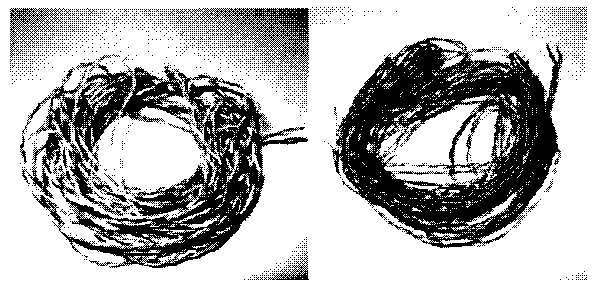Method for recovering metals in waste thin electric wires, messed electric wires or miscellaneous electric wires by thermal decomposition
A recycling method and wire technology, applied in the field of resources and environment, can solve the problems of inseparability, environmental pollution, different scales, etc., and achieve the effect of meeting the requirements of subsequent processes, meeting the requirements of resource recovery, and no oxidation mechanical loss.
- Summary
- Abstract
- Description
- Claims
- Application Information
AI Technical Summary
Problems solved by technology
Method used
Image
Examples
example 1
[0019] (1) The thin wire with insulated PVC sheath is first subjected to thermal treatment. In an inert atmosphere, the wire material is heated at a heating rate of 10°C / min to 580°C and kept at a constant temperature for 20 minutes;
[0020] (2) Take out the thin wires treated in (1) and perform minor mechanical interference; the remaining attachments outside the metal wires fall off automatically, and the metal basically remains unchanged; the metal recovery rate reaches 99%.
example 2
[0022] (1) Thermal treatment of thin wires with insulated polyethylene sheath, heating the wire raw materials at a heating rate of 20°C / min under an inert atmosphere to 650°C and holding it at a constant temperature for 10 minutes;
[0023] (2) Take out the thin wire treated in (1), and perform a slight vibration; a small amount of remaining attachments outside the metal wire will automatically fall off, and the metal will basically maintain its original state. The metal recovery rate is 99%.
example 3
[0025] (1) Put the messy wires with insulated polyvinyl chloride poly and insulated polyethylene sheaths together for thermal treatment. In an inert atmosphere, heat the wire raw materials at a heating rate of 15°C / min to 600°C and keep the temperature at 15°C. minute;
[0026] (2) After stopping the furnace for half an hour, take out the wire material treated in (1) and perform minor mechanical interference; the remaining attachments outside the metal wire will automatically fall off, and the metal will basically remain unchanged. The metal recovery rate is 99%.
PUM
| Property | Measurement | Unit |
|---|---|---|
| recovery rate | aaaaa | aaaaa |
Abstract
Description
Claims
Application Information
 Login to View More
Login to View More - R&D
- Intellectual Property
- Life Sciences
- Materials
- Tech Scout
- Unparalleled Data Quality
- Higher Quality Content
- 60% Fewer Hallucinations
Browse by: Latest US Patents, China's latest patents, Technical Efficacy Thesaurus, Application Domain, Technology Topic, Popular Technical Reports.
© 2025 PatSnap. All rights reserved.Legal|Privacy policy|Modern Slavery Act Transparency Statement|Sitemap|About US| Contact US: help@patsnap.com


